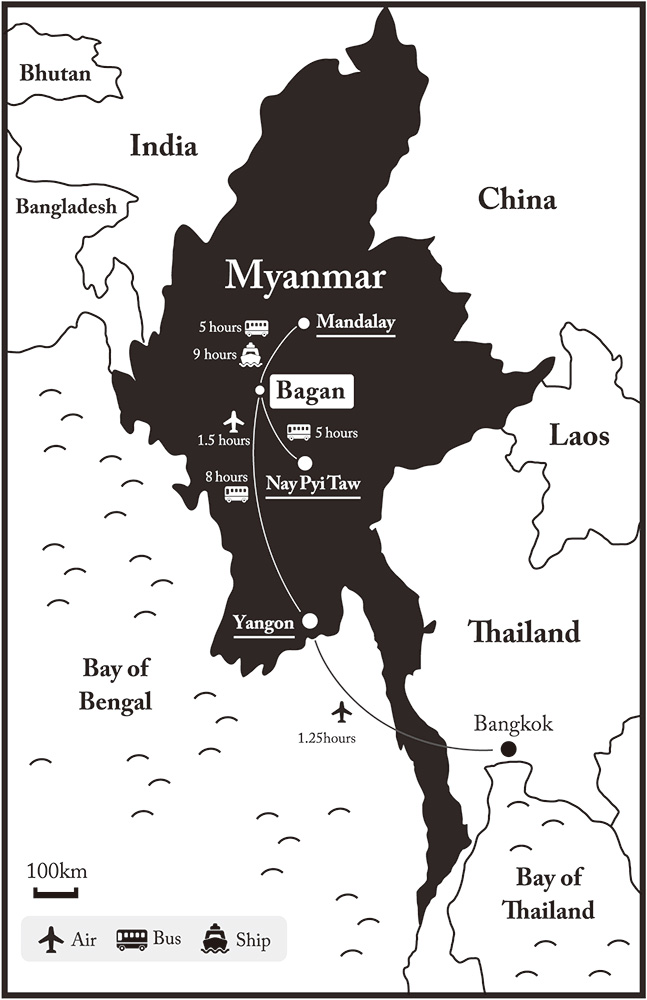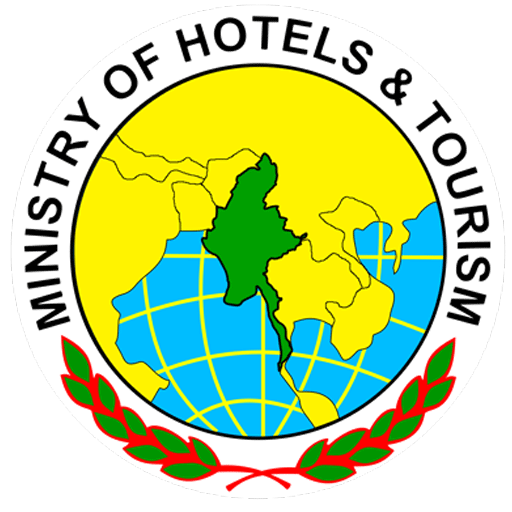Bagan
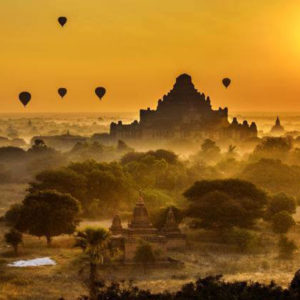 Temples of Bagan, The Most Impressive Archaeological Site in Asia
Temples of Bagan, The Most Impressive Archaeological Site in Asia
Bagan… these are temples and pagodas in sight, the ancient kingdoms of the Irrawaddy civilization; Bagan, the Burmese symbol and dream of travelers… We always lack words to describe this magical place!
On a plain of forty square kilometers on the left bank of the legendary Irrawaddy River totaled approximately 2,230 pagodas, monasteries and caves of all sizes and shapes. This is one of the most impressive archaeological sites in Asia.
The Bagan region which is on the bank of the legendary Irrawaddy River was ruled by 55 kings at the beginning of our era. It took off in the time of King Anawratha (1044-1077) who undertook the building of temples to house Buddha relics he had brought back from his many military campaigns.
This was how the construction of temples and pagodas began. The Bagan era ended in 1287 when the kingdom capitulated to the invading Mongols and Shans. For 300 years (from 10th to 13th century), some 4000 temples, pagodas, stupas were built.
The temples of Bagan were built of brick and covered with stucco. The shikharas, from India, were adopted by the architecture of Burma from the 10th century; they crowned many temples of Bagan. Apart from a few temples dedicated to Hindu gods some, most are places of Buddhist worship (Buddha, an Indian prince who managed to eliminate the suffering of his life and found his eternal happiness. His teaching has spread to several Asian countries).
The weather and natural disasters destroyed most of the temples even though more than 2,000 survived until today.
Several renovations have been made in recent years to protect this wonderful site. Bagan became a fabulous architectural heritage, a living outdoor museum, a must for any trip in this land of gold.
Bagan awaits you …!
You will be surprised by the beauty of its pagodas and stupas that emerge from the mist at sunrise or the unreal atmosphere at sunset. Feel free to browse through the small roads of the site drawn carriage or bike away from crowded tourists or if you want to have an unforgettable experience, fly over the plain in hot balloon at sunrise.
The most important temples are:
ANANDA TEMPLE
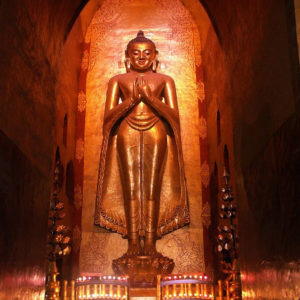 One of the most beautiful temples of Bagan with its architecture and large statues of Buddha covered in gold leaf. Built in 1105 by King Kyanzittha, it symbolizes the wisdom of Buddha. The temple has the shape of a Greek cross; the roof is composed of six successive terraces dominated by an Indian type of sanctuary turn. A very slender stupa, covered with gold and an umbrella ( hti ), rises to 55m in height. Several hundred wall niches containing Buddha are carved into the rock.
One of the most beautiful temples of Bagan with its architecture and large statues of Buddha covered in gold leaf. Built in 1105 by King Kyanzittha, it symbolizes the wisdom of Buddha. The temple has the shape of a Greek cross; the roof is composed of six successive terraces dominated by an Indian type of sanctuary turn. A very slender stupa, covered with gold and an umbrella ( hti ), rises to 55m in height. Several hundred wall niches containing Buddha are carved into the rock.SHWEZIGON PAGODA
 One of the most beautiful pagodas in the country. Construction began during the reign of King Anawrahtaen 1059 and was completed in the reign of Kyanzittha in 1090. The bell-shaped stupa, which was the model for the construction of other Burmese stupas, based on three superimposed terraces. Schwezigon is a Buddhist landmarks of Myanmar; it was built to house Buddha’s teeth. This pagoda, covered in gold leaf, is unique compared to other pagodas in Bagan built of brick.
One of the most beautiful pagodas in the country. Construction began during the reign of King Anawrahtaen 1059 and was completed in the reign of Kyanzittha in 1090. The bell-shaped stupa, which was the model for the construction of other Burmese stupas, based on three superimposed terraces. Schwezigon is a Buddhist landmarks of Myanmar; it was built to house Buddha’s teeth. This pagoda, covered in gold leaf, is unique compared to other pagodas in Bagan built of brick.DHAMAYANGYI TEMPLE
 The most massive temple of Bagan. Built on the model of the Ananda Temple, the temple is square, with projecting porches. The roof is composed of seven successive terraces. The interesting feature of this temple lies in the perfection of its construction, the bricks being perfectly assembled with cooking spray so that there are no gaps. Thatbyinnyu Temple: The temple above the archaeological site (61 m) . It was built by Alaungsithu (~ 1090-1167) in the middle of the twelfth century. This is one of the first temples built in 4 floors. The passage between the two massive cubes is built in a series of three terraces.
The most massive temple of Bagan. Built on the model of the Ananda Temple, the temple is square, with projecting porches. The roof is composed of seven successive terraces. The interesting feature of this temple lies in the perfection of its construction, the bricks being perfectly assembled with cooking spray so that there are no gaps. Thatbyinnyu Temple: The temple above the archaeological site (61 m) . It was built by Alaungsithu (~ 1090-1167) in the middle of the twelfth century. This is one of the first temples built in 4 floors. The passage between the two massive cubes is built in a series of three terraces.SULAMANI TEMPLE
 Large Buddhist temple built in 1181 by King Narapatisithu (1174-1211). It has large terraces on two levels that create a pyramid effect, where in every corner of the terrace there are small stupas. Inside the temple you can see one hundred monastic cells, a unique feature in Bagan. The frescoes, made by monks in the region, are very well kept and beautiful.
Large Buddhist temple built in 1181 by King Narapatisithu (1174-1211). It has large terraces on two levels that create a pyramid effect, where in every corner of the terrace there are small stupas. Inside the temple you can see one hundred monastic cells, a unique feature in Bagan. The frescoes, made by monks in the region, are very well kept and beautiful.HTILOMINLO TEMPLE
 Large Buddhist temple built in 1181 by King Narapatisithu (1174-1211). It has large terraces on two levels that create a pyramid effect, where in every corner of the terrace there are small stupas. Inside the temple you can see one hundred monastic cells, a unique feature in Bagan. The frescoes, made by monks in the region, are very well kept and beautiful.
Large Buddhist temple built in 1181 by King Narapatisithu (1174-1211). It has large terraces on two levels that create a pyramid effect, where in every corner of the terrace there are small stupas. Inside the temple you can see one hundred monastic cells, a unique feature in Bagan. The frescoes, made by monks in the region, are very well kept and beautiful.GAWDAWPALIN
 Large Buddhist temple built in 1181 by King Narapatisithu (1174-1211). It has large terraces on two levels that create a pyramid effect, where in every corner of the terrace there are small stupas. Inside the temple you can see one hundred monastic cells, a unique feature in Bagan. The frescoes, made by monks in the region, are very well kept and beautiful.
Large Buddhist temple built in 1181 by King Narapatisithu (1174-1211). It has large terraces on two levels that create a pyramid effect, where in every corner of the terrace there are small stupas. Inside the temple you can see one hundred monastic cells, a unique feature in Bagan. The frescoes, made by monks in the region, are very well kept and beautiful.SEINNYET NYIMA
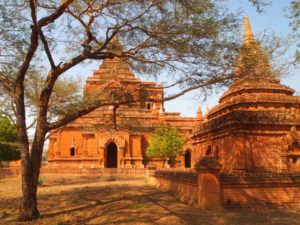 Seinnyet Nyima & Seinnyet Ama Paya (some call as Seinnyet Sister Temples) are quite interesting since they are two temples stand together, said to be built by Seinnyet Queen sisters: Seinnyet Ama (as the “Elder Sister”) is a temple, while Seinnyet Nyima (as the “Younger Sister”) is a pagoda, both are believed to be built in 11th century AD. The temple has four entrances with the spire on top the terraces, ornamented with decorative scrolls. Ogre-heads, mythical bird and animal figures. On the other hand, the pagoda is a three-terrace stupa with the bell shaped top, ornamented with moulded bands and orge-head pendants.
Seinnyet Nyima & Seinnyet Ama Paya (some call as Seinnyet Sister Temples) are quite interesting since they are two temples stand together, said to be built by Seinnyet Queen sisters: Seinnyet Ama (as the “Elder Sister”) is a temple, while Seinnyet Nyima (as the “Younger Sister”) is a pagoda, both are believed to be built in 11th century AD. The temple has four entrances with the spire on top the terraces, ornamented with decorative scrolls. Ogre-heads, mythical bird and animal figures. On the other hand, the pagoda is a three-terrace stupa with the bell shaped top, ornamented with moulded bands and orge-head pendants.

